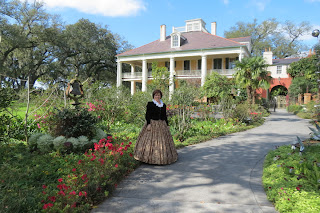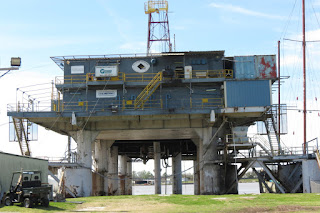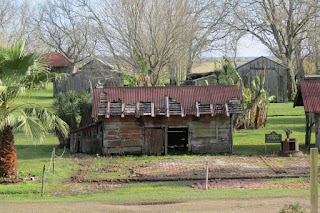Since we have finished the February project and are going to be here in March as well, we have a week to sight see and enjoy each others company. So, sight seeing and enjoying we did.

Our first stop was at a beautiful plantation named for the Houmas Indian tribe. They were the indigenous tribe in this region and they sold the area to the French in 1774.

The house has been very well restored and is ready for tours. The current owner still lives here and has provided all of the beautiful landscaping.
The entry is through a building which once was a part of the sugar extracting that went on at the plantation.
We were greeted in the garden by what many of the Cajuns call lunch.
The gardens are wonderful, even in the winter.
The owner has a very good eye for adornments to the gardens and pools.
This enormous live oak is over 500 years old and still going strong.
Some of the shrubs are beginning to bloom and soon the whole garden will be awash in color.
There are also a number of very tasteful decorations in the rooms. This is one of the "gentlemen" rooms.
We weren't allowed on the third floor as it is the residence of the owner but one can look up all the way to the roof through the circular stairwell.
Billie and our guide are admiring some of the fine things in the house. We got there early and had the guide all to ourselves.
It was beginning to warm outside and I believe we could have stood on the balcony and observed for a long while.
The guide introduced us to one of the mosquitoes which reside on the plantation.
In one of the dining halls they had a southern suicide boats, used in the Civil War. It couldn't quite submerge but it was very low in the water and carried a charge on a ram which was attached on the front of the craft.
We are now off to the next plantation. It happens to be on the other side of the Mississippi and this is the way to get there.
Barge traffic is heavy and constant.
The next plantation was Oak Alley.

This is why. There are rows of 300 year old oaks from the river in the background to the house. They served as a channel to funnel the cool breezes from the river into the plantation house.
When you were dining, the above device was the air conditioner. A young slave would sit in the corner and pull the cord you can see draped through the air and move the fan hanging over the center of the table.
This is one of the bedrooms. On the bed you can see a roller. The beds were filled with the Spanish moss and were very comfortable for one night. However, when you awoke the next morning there was a hollow spot where you had been laying. It was one of the slave's job to fluff the bed, and it may take several hours to get all the fluffing done, then he would take the roller and roll it out smooth.
Of course mosquito netting was obligatory for everyone.
Our next stop was a Creole plantation and it was very different. This one happened to be the home of Brair Rabbit. The story was originally a folk tale from the slaves. It was transcribed and renamed and later published as a child's story.
On this plantation the plantation "president" was, for several generations, a woman of the family. The last was Laura who can be seen in this back lit mirror.
The house was built well off of the ground because of the water and the cooling winds. The center two doors were not used to enter the house as they were the vents to cool the house. The men entered and occupied the left side of the house while the ladies used the right.
Our young guide, Creole by birth, was fascinating to listen to. He had a wonderful tale of the goings on of the family and the use of the house.
In one of the out buildings there was a listing of all the slaves with their value and their definition.
The kitchen for these families was never in the house. That would cause too much heat and was a constant fire danger.
After we left the plantation we went to Morgan City and spent the night there. The next morning we made our way to the docks where the major business is, of course, ship and oil rig building and repair.
Traveling up the river there was a major bottle neck caused by this railroad bridge. It was just wide enough to allow one vessel through at a time.
Our next stop was to see the first oil platform to be built. It was named Mr. Charlie for the man who put up the money to build it. It was all built out of surplus Navy parts.

It was a massive structure in it's time but now is too small and cannot be used in the deeper water. So they set it in the harbor and use it as a training platform for those who want to get a job on a platform.
On the platform we were guided by a man who had spent some time on platforms and knew a lot about the history of them.
Our next stop was to a museum for aviation and logging. The planes in the museum were all used in racing during the early years of flight. This plane was flown by a man in a race then by his wife in another. They both set speed records.
On the other side of the museum we found information about the early cypress logging industry. These cones were attached to the top of large logs to make them easier to drag out of the swamp.
All in all it was a great two days together with the God who made it all.

































































